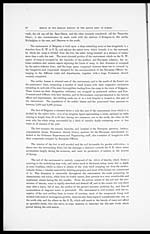Medicine - Institutions > Army health reports and medical documents > Sketch of the medical history of the native army of Bombay > Sketch of the medical history of the native army of Bombay, for the year 1870
(104) Page 39
Download files
Individual page:
Thumbnail gallery: Grid view | List view

POONA DIVISION OF THE ARMY.
39
ing, which acted injuriously on many of the men who were debilitated by previous attacks of
fever, causing their frequent resort to hospital. A very large number of cases of contusion,
abrasions, and other local injuries was unavoidably caused in the course of the various kinds
of labour entailed in building, and swelled the sick list to a large extent. This hypothesis is borne
out by comparison of the daily average number of sick from January to May, and that from June
to December (after line building had ceased), the former being 36.6 the latter 14.9. In mention-
ing the exposure of the men to malaria, I allude to the practice of sending out parties to the
jungle for the purpose of wood-cutting which entailed a residence in unhealthy localities such
as the Beedee district. To avoid as far as possible the injurious effects arising from this
unavoidable measure, the precaution was taken during the past year of changing the working
parties more frequently, and of removing them at night to some distance from the jungle, and
a dose of quinine was administered to each man in the morning before he proceeded to work.
By these means I believe the amount of sickness was diminished, both as to the number of
cases and the type of fever resulting from the exposure, the cases of fever being much milder
and less complicated with pneumonia than during the previous year. 334 cases of intermit-
tent fever have been under treatment during 1870, none of which terminated fatally, though
in some cases the cause of frequent readmissions into hospital owing to repeated attacks of
the disease.
Four cases of small-pox occurred during the year, the disease having broken out in April
amongst the Regimental followers; precautions were taken to segregate those attacked by
this disease, which was therefore confined to the above limited number, of these 3 had
been previously vaccinated.
Vaccination has been practised throughout the year and the supply of lymph has been
of good quality; a great number of the Regimental followers, having been found unprotected,
were vaccinated, and precautions taken for the inspection and vaccination of all persons per-
mitted to reside within the Regimental lines.
Three deaths have occurred in hospital during the year, one from remittent fever, one
from dysentery, and one from phthisis, making the proportion of deaths to average strength
0.4, and the percentage of deaths to the number of treated 0.4. A private belonging to the
5th Regiment N. I. died in the Grenadier hospital from laryngitis; this man was left behind
when his Regiment marched from Belgaum en route for Aden in November last, being too
ill to accompany his corps, and died within a few hours after his admission.
The hospital (as before remarked) affords very insufficient accommodation for the re-
quirements of the Regiment, being only adapted for the reception of 16 men. During the past
year it has been found necessary to pitch tents in the hospital compound for the reception and
treatment of those patients for whom there was no room in the ward. There is also an
entire absence of quarters for hospital assistants and medical pupils; the former are there-
fore obliged to occupy two of the cookrooms provided for the use of patients, the latter live
in a small building erected for the purpose of a store room.
A ward for the contagious diseases is greatly wanted, and has been before recommended
by the Sanitary Commissioner, but has not yet been erected.
The hospital establishment is complete and the medical subordinates are attentive to their
duties. I have pleasure in testifying to the zeal and intelligence of 2nd Class Hospital Assistant
Bhowanee Sing, attached to the Regiment, 3rd Class Hospital Assistant Gunesh Succaram has
also given me entire satisfaction.
Topography of the Station.
The military station at Belgaum is situated in the Southern Maratha Country in latitude
15° 22" N. and longitude 74° 42" E., at an elevation of from 2,100 to 2,260 feet above the sea,
from which it is distant about 50 miles in a direct line eastward, and 15 miles from the west of
the Western Ghauts. It has communication with Vingorla (on the sea coast) by two made
Set display mode to: Large image | Zoom image | Transcription
Images and transcriptions on this page, including medium image downloads, may be used under the Creative Commons Attribution 4.0 International Licence unless otherwise stated. ![]()
| Permanent URL | https://digital.nls.uk/75007029 |
|---|




